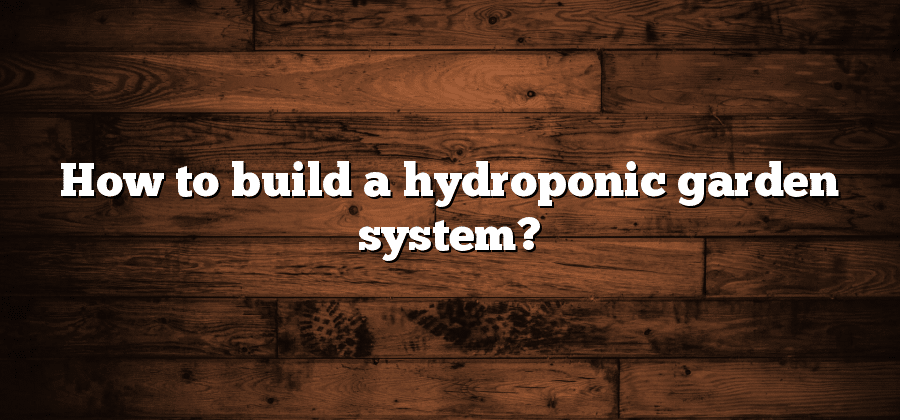Understanding the Basics of Hydroponic Gardening
Hydroponic gardening is a modern and efficient method of growing plants without the use of soil. Instead, plants are grown in a nutrient-rich solution that provides all the necessary elements for their growth. This technique has gained popularity due to its numerous advantages, such as increased yield, faster growth, and the ability to grow crops in any environment.
One of the key elements in hydroponic gardening is the control over the plant’s root system. In traditional gardening, the roots are spread out in the soil, searching for nutrients and water. However, in hydroponics, the roots are directly exposed to the nutrient solution, allowing the plants to absorb the essential elements more effectively. This method eliminates the need for the plant to search for nutrients, resulting in faster and healthier growth. Furthermore, by eliminating soil, the risk of pests and diseases is significantly reduced, making hydroponics a more sustainable and eco-friendly option.
Selecting the Right Hydroponic System for Your Needs
When it comes to selecting the right hydroponic system for your needs, there are a few factors to consider. First and foremost, you’ll need to determine the size and scale of your garden. Are you looking to grow a few plants for personal use, or do you have ambitions of a larger commercial operation? This will help guide you in choosing the appropriate system that can accommodate the number of plants you wish to grow.
Another important factor to consider is the type of plants you plan to cultivate. Different crops have different requirements, and certain hydroponic systems may be better suited for specific types of plants. For example, nutrient film technique (NFT) systems work well for leafy greens like lettuce, while ebb and flow systems are ideal for flowering plants such as tomatoes or peppers. Understanding the specific needs of your plants will help you narrow down your options and choose the system that will provide optimal conditions for their growth.
Choosing the Ideal Location for Your Hydroponic Garden
When it comes to choosing the ideal location for your hydroponic garden, there are a few key factors to consider. First and foremost, you’ll want to ensure that your chosen space receives adequate sunlight. Most plants require a minimum of six hours of direct sunlight per day, so selecting an area that is free from shade or obstructions is crucial. Be mindful of any nearby trees or buildings that may cast shadows and hinder the growth of your plants.
Another important factor to consider is the availability of water and electricity. Since hydroponic gardens rely on a constant supply of water and nutrients, it’s essential to have access to a reliable water source. Additionally, you’ll need to ensure that your chosen location has access to electrical outlets for running the necessary equipment, such as pumps and timers. If your selected area doesn’t have access to these utilities, you may need to make arrangements for alternative solutions, such as using rainwater harvesting systems or solar-powered equipment.
Gathering the Essential Equipment for Your Hydroponic Setup
To ensure a successful hydroponic setup, it is crucial to gather the essential equipment that will support your gardening needs. The first item on your list should be a suitable container or reservoir to hold the nutrient solution. This container should be opaque or dark in color to prevent light infiltration, which can lead to algae growth. Additionally, you will need a water pump or air stone to ensure proper aeration and circulation of the nutrient solution.
Next, you will require a growing medium that will provide support and stability for your plants. Common options include coco coir, rockwool, or perlite. These materials facilitate the absorption and distribution of moisture and nutrients to the plants’ roots. Additionally, a pH and EC (electrical conductivity) meter is essential for monitoring and adjusting the nutrient solution’s acidity and nutrient levels. This allows you to maintain an optimal environment for your plants to thrive.
Furthermore, having a reliable light source is crucial for hydroponic gardening, as plants need sufficient light for photosynthesis. LED grow lights are often recommended due to their energy efficiency and adjustable spectrum options, allowing you to cater to the specific needs of your plants. Adequate ventilation is also necessary to control temperature and humidity levels within your hydroponic system. A combination of exhaust fans and air filters can help maintain a healthy and optimal growing environment.
Lastly, investing in appropriate tools such as trimming scissors, measuring instruments, and watering cans will aid in maintaining your hydroponic garden. These tools will enable you to properly care for and manage your plants, ensuring their growth and overall health. By gathering the essential equipment mentioned above, you are well on your way to establishing a successful hydroponic setup and creating an ideal environment for your plants to flourish.
Creating a Nutrient Solution for Optimal Plant Growth
Hydroponic gardening relies on a nutrient solution to provide plants with the necessary elements for robust growth. Creating a well-balanced and effective nutrient solution is a key factor in achieving optimal plant growth and maximizing yields. With careful consideration and the right ingredients, it is possible to tailor the nutrient solution to meet the specific needs of different plant varieties.
To start, it is important to understand the basic components of a nutrient solution. There are three primary elements that plants require in large quantities: nitrogen, phosphorus, and potassium. These are commonly referred to as NPK and are often represented by three numbers on fertilizer labels. In addition to these macronutrients, plants also need micronutrients like iron, manganese, and zinc, which are required in smaller quantities but are equally essential. By incorporating these elements into the nutrient solution, plants are provided with everything they need to thrive in a hydroponic system.






